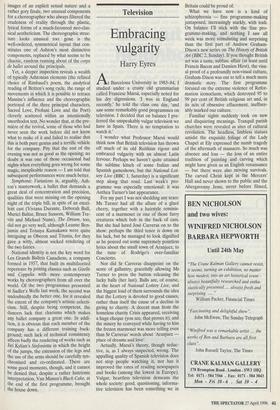Dance
Who are you?
Giannandrea Poesio
The preservation of both a national choreographic style and a distinctive stylis- tic identity is a troublesome issue for many ballet companies today. Within the last 20 years, the abolition of geographical and ideological barriers has favoured a process of artistic interaction between different institutions that has affected greatly the dance world. Works that used to be exclu- sive to the repertoire of a specific company or to the culture of a particular country are now being performed worldwide. This artistic policy, however, has gradually erod- ed the individuality of some major compa- nies, causing serious concern among the experts and great discontent among the most traditionalist ballet-goers.
In most cases, the mixture of imported techniques and the performing require- ments which dancers have to cope with has inevitably undermined the well-established set of artistic formulae — often informed by contextual `national' factors — that con- ferred a unique identity on each ballet company. Aware of the problem, some artistic directors have tried to rescue, more or less successfully, the endangered nation- al choreographic tradition by resorting to a series of revivals. Those who attend regu- larly the Royal Opera House know that this is the case with the works by Frederick Ashton, regarded by many as the father of the so-called 'English style'.
Of all Ashton's revivals we have seen since a long time, Les Illuminations, the opening piece of the triple bill currently performed by the Royal Ballet, is probably the most interesting. At first glance this is the least Ashtonian of all the Ashton works, for it contains choreographic and dramatic elements that do not match the standard idea one might have of his style. Originally created for New York City Bal- let in 1950, the ballet contains strong images of an explicit sexual nature and a rather gory finale, two unusual components for a choreographer who always filtered the crudeness of reality through the plastic, lyrical forms of a much-favoured neo-clas- sical aestheticism. The choreographic struc- ture looks unusual too: gone is the well-ordered, symmetrical layout that con- stitutes one of Ashton's most distinctive components, replaced by what seems to be chaotic, random running about of the corps de ballet around the principals.
Yet, a deeper inspection reveals a wealth of typically Ashtonian elements (the refined choice of Rimbaud's poem, the analytical reading of Britten's song cycle, the range of movements in which it is possible to retrace Massine's influence and the choreographic portrayal of the three principal characters, Sacred Love, Profane Love and the Poet) cleverly scattered within an intentionally unorthodox text. No wonder that, at the pre- mière of the revival, some of those who had never seen the work before did not know what to make of it and failed to realise that this is both pure genius and a terrific vehicle for the company. Pity that the rest of the evening was not as good as the opening; no doubt it was one of those occasional bad nights when everything goes wrong for some magic, inexplicable reason — I am told that subsequent performances were much better.
Symphonic Variations is, arguably, Ash- ton's masterwork, a ballet that demands a great deal of concentration and precision, qualities that were missing on the opening night of the triple bill, in spite of an excel- lent cast (Viviana Durante, Deborah Bull, Muriel Baltat, Bruce Sansom, William Tre- vitt and Michael Nunn). The Dream, too, did not go very well, although Leanne Ben- jamin and Tetsuya Kumakawa were quite intriguing as Oberon and Titania, for they gave a witty, almost wicked rendering of the two fairies.
National identity is not the key word for Les Grands Ballets Canadiens, a company formed in 1957, that built its multifaceted repertoire by joining classics such as Gthelle and Coppelia with more contemporary works by choreographers from all over the world. Of the two programmes presented at Sadler's Wells last week, the second was undoubtedly the better one, for it revealed the extent of the company's artistic eclecti- cism. Still, despite being competent, the dancers lack that charisma which makes any ballet company a great one. In addi- tion, it is obvious that each member of the company has a different training back- ground; such lack of technical consistency affects badly the rendering of works such as Jiri Kylian's Sinfonietta in which the height of the jumps, the extension of the legs and the use of the arms should be carefully syn- chronised and co-ordinated. There are some good moments, though, and it cannot be denied that, despite a rather histrionic interpretation, Van Manen's Black Cake, at the end of the first programme, brought the house down.



























































 Previous page
Previous page